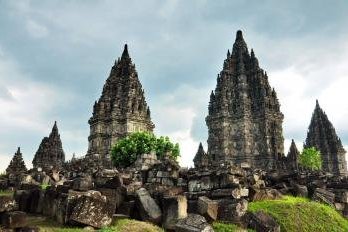
After an amazing trip to Krakatoa, I decided to choose Indonesia as a destination for Christmas holiday as I wanted to fulfil my dream to explore the Javanese culture and learn the cultural route from India to Southeast Asia, and Yogyakarta is a perfect place to go for 2 great World Heritage Sites nearby, Borobudur and Prambanan. I decided to rent a car with a driver, after I arrived in Yogyakarta and had delicious local fried chicken for lunch near airport; the driver immediately took me to visit Prambanan, as he afraid that there will be a thunderstorm in the late evening. The local guide explained to me that Prambanan means countless Hindu priests in Sanskrit for its 240 small temples surrounded the main temple. When I reached the complex, the spires of the main temple complex were the first thing I saw, the structural design is really beautiful, high slender and impressive that reminded me the original but much shorter and wider in South India. It is amazing that this Indian styled architecture crossed the ocean to Southeast Asia and became a model of many Hindu temples in this region including Angkor.
Only the main temple complex and few small temples have been restored to its original form, most of the complex is the piles of stone since the complex is located in the earthquake prone area, its design cannot stand the quake well. My local guide said that Indonesian Government is not rushing to restore the whole complex to its former glory because it is a Hindu temple and in Indonesia, only Balinese is still practicing Hindu not Javanese who are mostly Muslim so no strong public support. Also, they also lack 3 Ms, money (no budget), man (no good craftsman) and materials (lava rock from the nearby Mt. Merapi). When I reached the main temple complex dedicated to three highest gods of Hindu and their mythical vehicles, the details of stone craving are really stunning and beautiful. The most stunning is the biggest temple for Shiva; the temple has 4 rooms, each room for Shiva or his family. After that my guide took me to the spots where I could take good photos behind the complex. Then I took a mini train to see Candi Sewu, a Buddhist temple nearby. The temple complex layout is similar to Prambanan that many small temples surrounded the main one like mandala. Similar to Prambanan, most of the temples are just the piles of collapsing rock only the main temple and few minor ones are fully restored. I really like the unique design that the spires are in the shape of stupa which is the big contrast to Prambanan. After Candi Sewu, I rode mini train to the exit of the complex and suddenly the really heavy rain started to pour down, so I ran back to the car and ended my enjoyable trip to Prambanan.
Prambanan is really a great sight and exceed my expectation. The size of the temple is smaller than I thought but it is still impressive. Since I saw My Son of Champa in Viet Nam few months ago, I felt that the arts of these two pre-Angkor Hindu sites in Southeast Asia are really different. While I found that there are many similarities between Angkor, My Son and Hindu temple in India especially the temple design and function. Prambanan is really different; the closest similarity is the pre-Angkor temple in Rolous, Cambodia, echoing my history class that early Angkor civilization may came from Java, and the Khmer art reached its zenith when they finally combined both schools of Java and Champa after Angkorian conquered My Son. Seeing Prambanan also completed my dream to see the cultural route of South Indian to Southeast Asia and learned how the art developed from Temple of Dawn in Bangkok then Ayutthaya, Angkor, My Son and finally Prambanan, 5 years of enjoyable trips.
More on
Comments
No comments yet.
